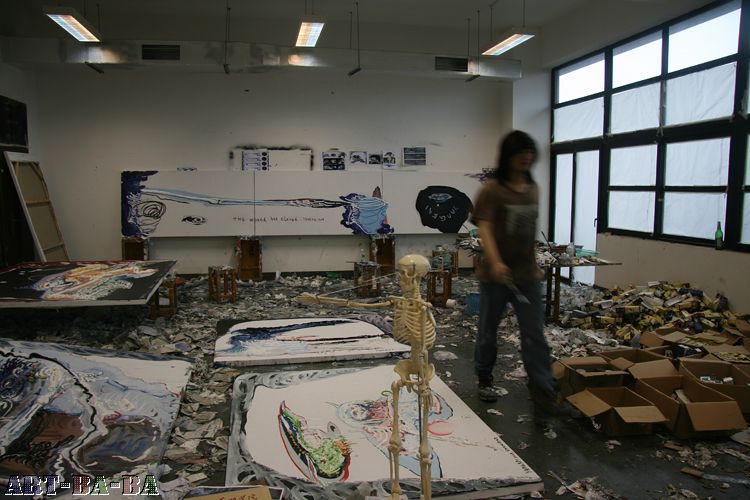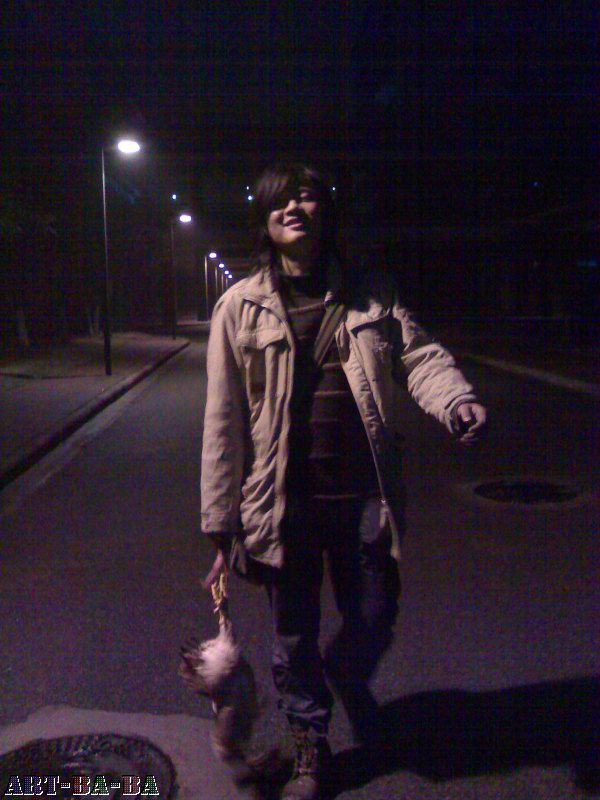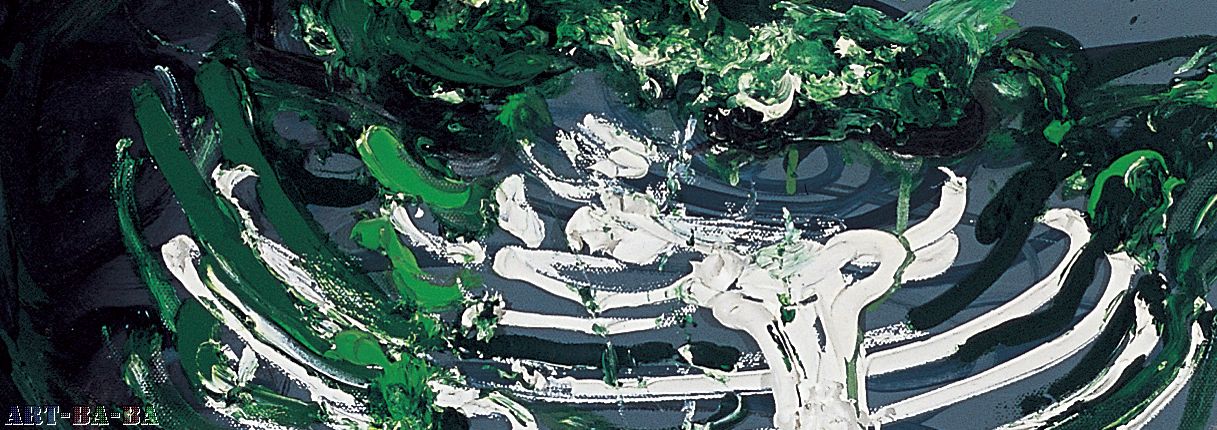王春辰:意义与骨骼——谈杨锴对身体性的探索

意义与骨骼
——谈杨锴对身体性的探索
Significance and Bones
- About Yang Kai’s Exploration of Bodyness
王春辰
如今,绘画遇到的瓶颈是,任何一种方法似乎都有人使用过,绘画的路径好像已经到头。批评界对绘画的现状与发展也是争论不休,同时也更期待绘画再创造出新的感觉、新的样式。
第一次看到杨锴的作品,很吃了一惊。如果不说他才是大四的学生,还会以为是绘画上已经磨练了多年的成熟画家。他果断、在做深入思考,从他的画面上可以体会到他面对画布时脑海里涌现的思绪远远比画面呈现的要多。如果不是想了很久,他做不到果断;果断是因为他放弃了画布被赋予的二维幻觉主义绘画语言体系,而直接呈现画布属性、颜料的物质属性,在直接的倾述中又寻找着某种东西。这在新一代的年轻画家中是难能可贵的自我标准:不追求流行、不放弃自我、以思考面对画布。
杨锴的画,虽然消解了视觉物象的一般构成,但在粗放中隐匿着意义的追寻,它们成为杨锴解读世界的方式,读者在面对他的作品时也要用这独特方式才能进入画面。作品中的对象既有宗教传说人物,也有故事人物,也有动物形象,但无一不是以骨骼的形式来呈现出来,就像透视效果一样。画面虽然构筑了自由、凸凹起伏的形状,但冲击于视觉的却是它们的意义设问。对于观者,这是一种疑问:当最内在的东西被揭示后,我们要解读什么。当问题展开后,我们是否准备好答案。如果绘画被消解,仅仅是现代主义追求的一种技法革命,那么到了当代艺术,绘画被解构与重组就不仅仅是技术前卫,而是一代艺术家对新的价值问题的追问。这里的骨骼是生命的支撑,也是生命体的象征,但是否是生命本身,却是一道足够思辨的难题。
这恰恰是我们今天要面对的身体性问题,从生命源起到社会进化再到生命密码的破解,不仅是进化论者、生物学家的课题,也是哲学家、思想家思考的对象:身体并非物质,性别并非生理,生命有更高级的存在形式。骨骼在文化含义常常是,对于医学,它是解剖生命肌理的一种结构,予以诊断病理症候;对于宗教,它给人以生命死亡的象征和再生的可能。而对于杨锴,他可能的思考则是一种询问,询问一种意义如何实现的方式,无论他选择的绘画对象,还是他命名的题目,都显示着他在寻找某种东西,一种属于他的艺术追求的东西。对于当下,这种追求显得曲高和寡,显得深郁沉重,但对于一代新人而言,这是必须要做的,因为我们依然是一样的存在者,从古迄今未有改变,一样恒久地面临着终极设问:身体的意义与生命的意义。哲学上回答不了,就在宗教里;宗教里难以释怀,那就在艺术里幻想、沉浸。
作为年轻画家,杨锴可以继续思考与幻想下去。
2010-2-13 于中央美院-北京
Significance and Bones
- About Yang Kai’s Exploration of Bodyness
by Wang Chunchen
(余博雅译)
Nowadays, the bottleneck painting encountered is that every method seems to be used before, as if the road of painting has already come to the end. Critics of the painting's present situation and development is being debated, at the same time they also look forward to recreating a new sensation, new style of painting.
The first time I saw Kai Yang's works, I was surprised. Had I not been told that he was merely a senior university student, I would thought it was painted by a sophisticated painter with years of experience. He is decisive and thoughtful. From his painting one can feel that he is thinking much more when facing the canvas are far than the painting itself can present. He cannot be decisive without thinking for a long time; he is decisive because he has abandoned the two-dimensional illusionistic painting language given to the canvas; instead he tries to present directly the properties of the canvas and the material attributions to the paint, pursuing something else in the direct expression. This is a commendable self-standard for the new generation of young artists: they do not follow fashion and do not give up self and think when facing the canvas.
Although Yang Kai's paintings have cleared up the general composition of visual image, hidden underneath the crudeness is pursue of meaning, which has become Yang Kai’s way of interpreting the world, a unique one that readers will have to use to enter his work. The figures in his works could be religious or legendary persons, or characters, animals. All are presented in a skeleton form like a perspective. His paintings have constructed free, undulating convex-concave forms, but what impacts on the vision is their questioning of meaning. For the viewer, this is a query: When the internal things have been revealed, what shall we interpret? When the problem is unfolded, are we prepared with a good answer? If painting being counteracted is just a technique revolution seeked by modernism, then in contemporary art, the deconstruction and reorganization of painting is not just an avant-garde technique, but an inquiry of new value by a generation of artists. The skeleton here is life support, and also a symbol of life, but whether it is life itself is a puzzle worthy of speculation.
This is precisely the problem of corporality we have to face. Questions like the origin of life, social evolution and decipherment of life codes, are not only research topics for evolutionists and biologists, but also subjects of enquiry for philosophers and thinkers: the body is not material; gender is not physiological; life can take on a more advanced form of existence. The cultural meaning of skeleton is often, in medicine, a structure in anatomy for diagnosing symptoms; in religion, a symbol of death and possibility of rebirth. To Yang Kai, his possible thought is an inquiry, a questioning about how meaning to be achieved. Whether it is the painting object he has chosen or artwork title he has given, both have shown that he is looking for something which belongs to his art pursuit. For the moment, the pursuit seems to be highbrow, distressing , but to the new generation, this must be done, because we are the same beings who have not changed since ancient times, facing with the ultimate long-lasting question: the physical significance and meaning of life. If philosophy is not able to answer it, then it might be in religion; if it is difficult to reconcile in religion, then it shall be in fantasy and immerse of art.
As a young painter, Yang Kai can continue thinking and fantasy.
Written at China Central Academy of Fine Arts in Beijing on 13rd, February, 2010

春辰一个字多少银子

个人简介
杨锴 1986年出生于湖南
2006年考入广州美术学院,现就读于油画系。
